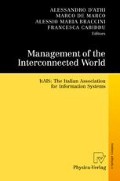Abstract
Today, the lives of both people and organizations are strongly focused on the creation, development and maintenance of relationships. These are influenced by several factors, amongst which trust plays an important role. Same as in traditional relationships, trust is considered crucial in their digital equivalent; here we can speak of the concept of trust in technology. An example for trust in technology is given by biometric authentication and authorization infrastructures. A possible approach is the use of typing behavior biometrics as authentication method. This provides a higher security, considering several biometric specific problems like replay attacks or template aging. The intra-organizational environment allows an interesting solution to these problems, namely the synchronization of biometric data within a federation of applications running in the same company. This paper presents the influence of the proposed authentication model on trust by means of the technical-formal-informal model inside an organization.
Access this chapter
Tax calculation will be finalised at checkout
Purchases are for personal use only
Preview
Unable to display preview. Download preview PDF.
References
Chiles TH, McMackin J (1996) Integrating variable risk preferences, trust, and transaction cost economics. Acad Manage Rev 21(1):73–99
Rousseau MT, Stikin SB, Burt SB, Carmerer C (1998) Not so different after all: across-discipline view of trust. Acad Manage Rev 23(3): 393–404
Kramer RM (1999) Trust and distrust in organizations: emerging perspectives, enduring questions. Ann Rev Psychol 50(1):569–598
Mayer RC, Davis JH, Schoorman FD (1995) An integrative model of organizational trust. Acad Manage Rev 20(3):709–734
McKnight DH, Chervany NL (2001) Trust and distrust definitions: one bite at a time. In: Falcone R, Singh MP, Tan Y (eds) In Proceedings of the workshop on deception, fraud, and trust in agent societies held during the autonomous agents conference: trust in cyber-societies, integrating the human and artificial perspectives lecture notes in computer science, vol. 2246. Springer, London, pp 27–54
Levi M (1996) Social and unsocial capital: a review essay of Robert Putnam’s “making democracy work”. Polit Soc 24(1):45–55
Bhattacherjee A (2002) Individual trust in online firms: scale development and initial test. J Manage Inf Syst 19(1):211–242
Williamson OE (1985) The economic institutions of capitalism. Free Press, New York
Eisenhardt K (1985) Control: organizational and economic approaches. Manage Sci 31(2):134–149
McKnight DH, Cummings LL, Chervany NL (1998) Initial trust formation in new organizational relationships. Acad Manage Rev 23(3): 473–491
Granovetter M (1985) Economic action and social structure: the problem of embeddedness. Am J Sociol 91(November): 481–510
Misiolek NI, Zakaria N, Zhang P, (2002) Trust in organizational acceptance of information technology: a conceptual model and preliminary evidence. In Proceedings of the decision sciences institute 33rd annual meeting 2002, San Diego
Ratnasingam P, Pavlou P (2002) Technology trust: the next value creator in B2B electronic commerce. International resources management association conference, Washington, Seattle
Reeves B, Nass C (1996) The media equation. How people treat computers, television, and new media like real people and places. Cambridge University Press, New York
Schläger C, Sojer M, Muschall B, Pernul G (2006) Attribute-Based authentication and au-thorisation infrastructures for e-commerce providers. Springer, Krakow, pp 132–141
Liebenau J, Backhouse J (1990) Understanding information: an introduction. Macmillan, London
Gambetta D (1988) Trust: making and breaking cooperative relations. Basil Blackwell, Oxford
Kumar K, Becerra-Fernandez I (2007) Interaction technology: speech act based information technology support for building collaborative relationships and trust. Decis Support Syst 43(2):584–606. DOI= http://dx.doi.org/10.1016/j.dss.2005.05.017
Ba S, Whinston AB, Zhang H (1999) Building trust in the electronic market through an economic incentive mechanism. In: Proceedings of the 20th international conference on information systems (Charlotte, North Carolina, United States, December 12–15, 1999). International conference on information systems. Association for Information Systems. Atlanta, GA, pp 208–213
Ratnasingam P (2002) The importance of technology trust in web services security. Inf Manage Comput Secur 10(5):255–260
Koller M (1988) Risk as a determinant of trust. Basic Appl Soc Psychol 9(4):265–276
Lewicki RJ, Bunker BB (1996) Developing and maintaining trust in work relationships. In: Kramer RM, Tyler TR (eds) Trust in organizations: frontiers of theory and research. Sage Publications, Thousand Oaks, pp 114–139
Pavlou P, Tan YH, Gefen D (2003) Institutional trust and familiarity in online interorganizational relationship. In Proceedings of the 11th European conference on information systems, Naples, Italy, June 19–21, 2003
Spagnoletti P, Za S, D’Atri A (2007) Institutional Trust and security, new boundaries for virtual enterprises. In Proceedings of 2nd international workshop on interoperability solutions to trust, security, policies and QoS for enhanced enterprise systems, IS-TSPQ2007, Funchal, Portugal
Tyler TR, Degoey P (1996) Trust in organizational authorities. The influence of motive attributions on willingness to accept decisions. In Kramer RM, Tyler TR (eds) Trust in organizations: frontiers of theory and research. Sage Publications, Thousand Oaks, pp 331–350
Qarchive (2008) Database synchronization, database-synchonization.qarchive.org. Retrieved 1 Oct 2008
Author information
Authors and Affiliations
Corresponding author
Editor information
Editors and Affiliations
Rights and permissions
Copyright information
© 2010 Springer-Verlag Berlin Heidelberg
About this paper
Cite this paper
Olden, M., Za, S. (2010). Biometric Authentication and Authorization Infrastructures in Trusted Intra-Organizational Relationships. In: D'Atri, A., De Marco, M., Braccini, A., Cabiddu, F. (eds) Management of the Interconnected World. Physica-Verlag HD. https://doi.org/10.1007/978-3-7908-2404-9_7
Download citation
DOI: https://doi.org/10.1007/978-3-7908-2404-9_7
Published:
Publisher Name: Physica-Verlag HD
Print ISBN: 978-3-7908-2403-2
Online ISBN: 978-3-7908-2404-9
eBook Packages: Business and EconomicsBusiness and Management (R0)

